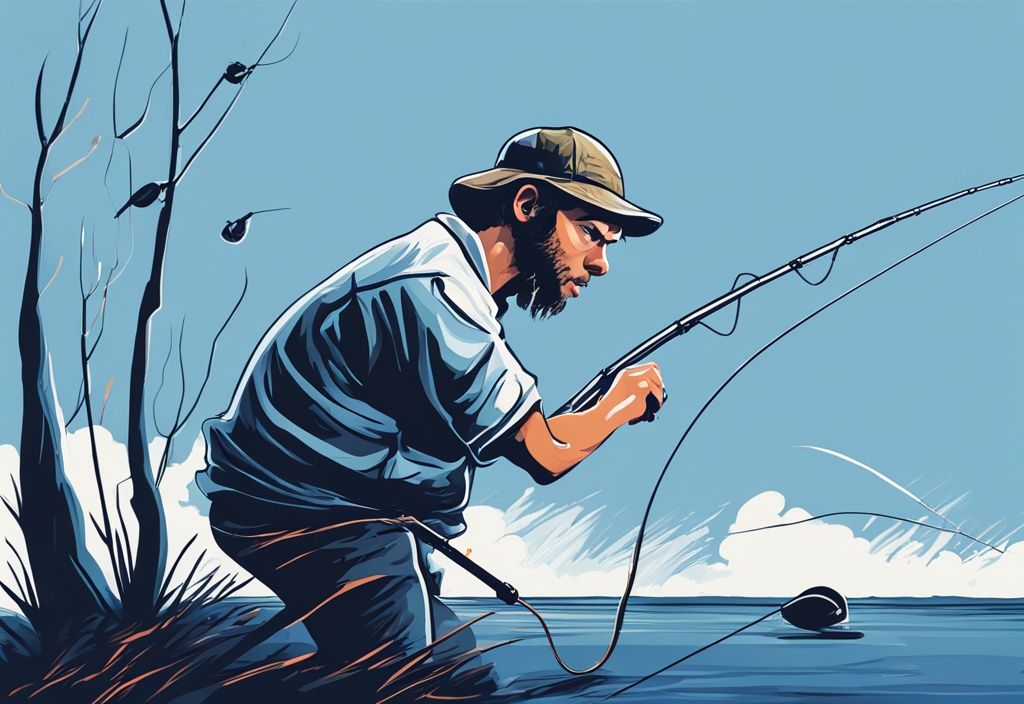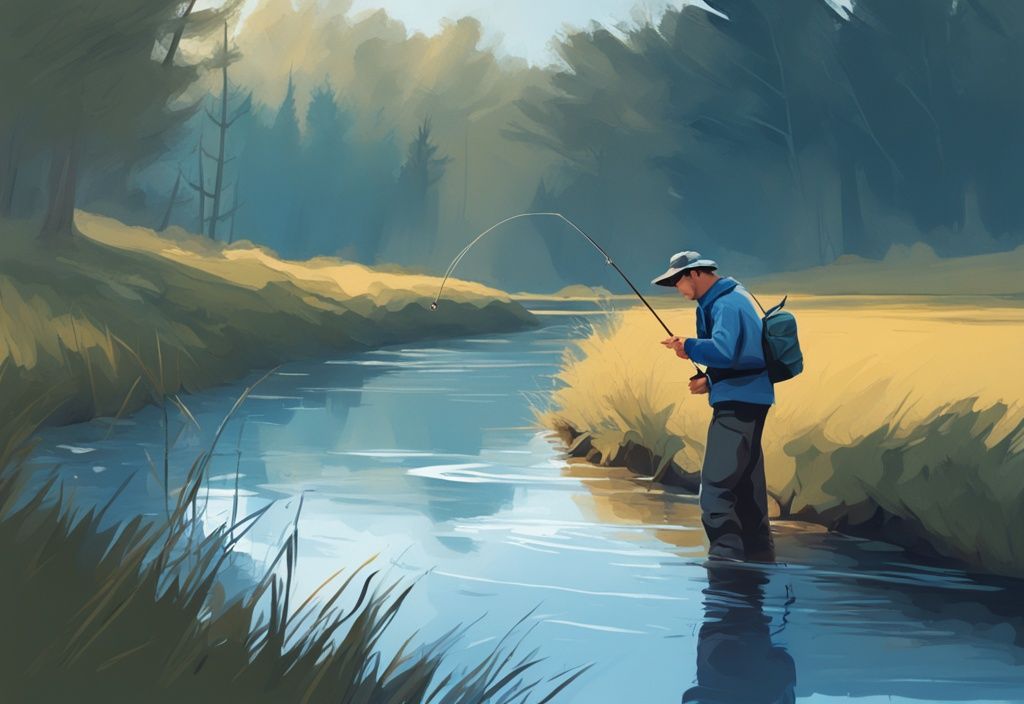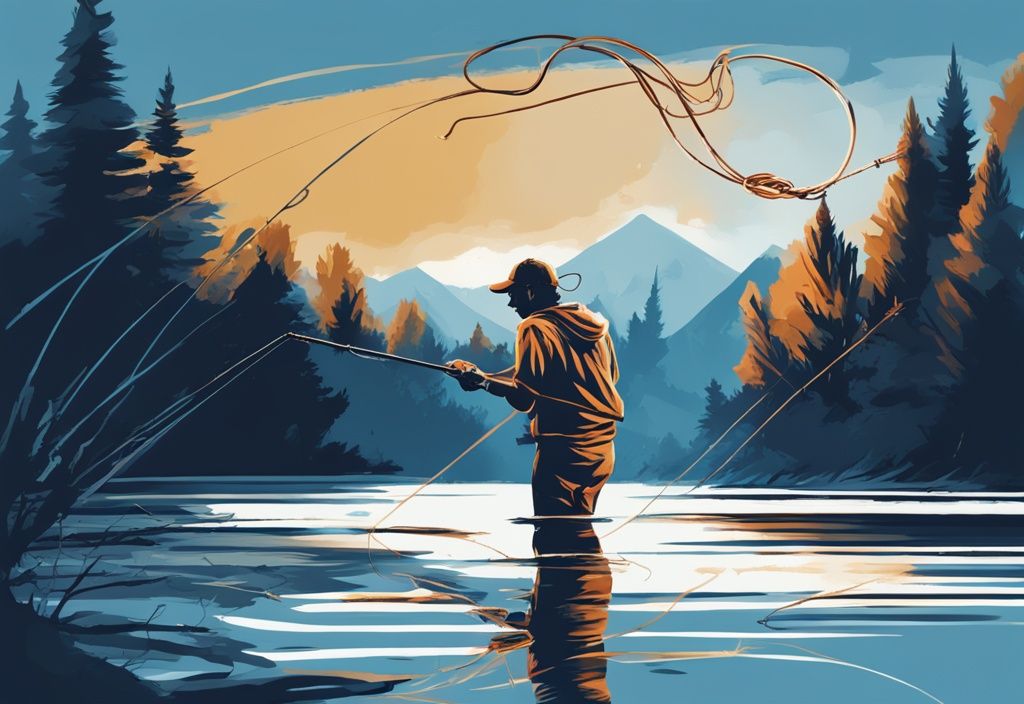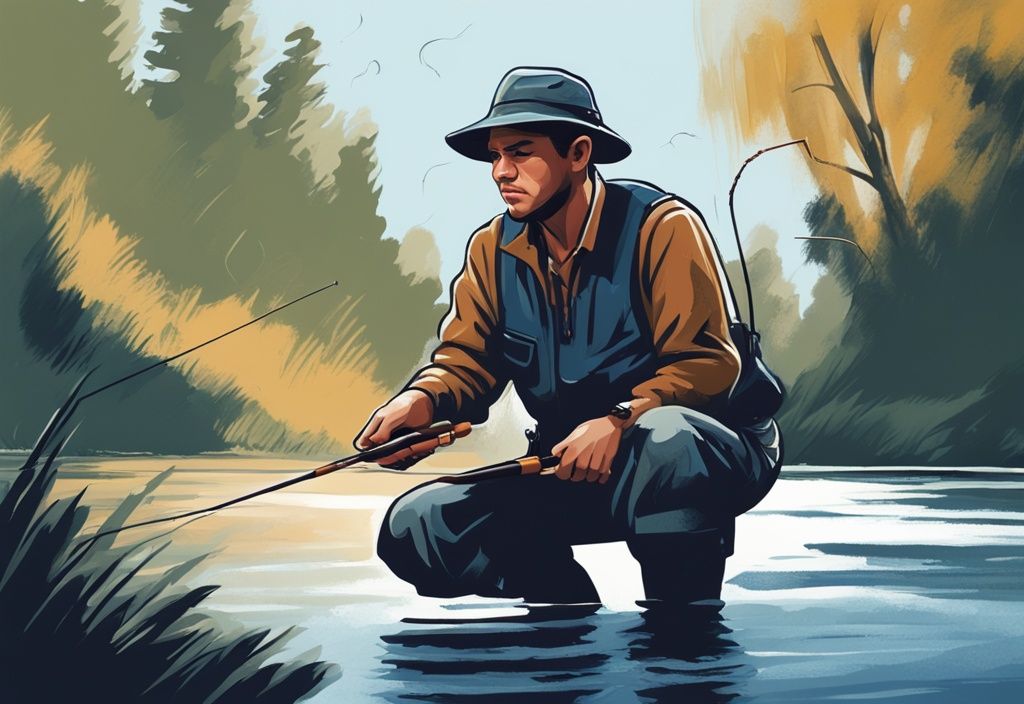Picture this: you’re knee-deep in a river, the sun warming your back, as you cast your line with a flick of the wrist. Sounds idyllic, right? But let me tell you, fly fishing is more than just a pretty picture. It’s a dance with nature, a test of patience, and yes, a bit of a puzzle. With a fly as light as a whisper, you’re not just fishing; you’re crafting an experience. So, is it really as tough as they say? Let’s wade into these waters together and find out.
Is Fly Fishing Really That Complicated?
Fly fishing often carries the reputation of being a complex and daunting sport, but this perception doesn’t reflect its true nature. At its core, fly fishing is an accessible activity that anyone can learn, regardless of their experience level. The belief that mastering fly fishing requires years of dedication is a common misconception. While it does involve a unique set of skills, these can be acquired with patience and practice.
Imagine standing knee-deep in a crystal-clear stream, the sun warming your back as you cast your line. Sure, fly fishing might seem intricate at first glance, but it’s not as complicated as it appears. The essence of fly fishing lies in the casting technique, which differs from conventional fishing. Instead of relying on the weight of a lure, fly fishing uses the weight of the line to propel the fly. Although this might sound challenging, it can be learned relatively quickly with consistent practice.
One of the beauties of fly fishing is its flexibility in terms of financial investment. Enthusiasts can choose to spend as much or as little as they wish, depending on their personal preferences and needs. Basic equipment is sufficient for beginners, allowing them to enjoy the sport without a significant financial burden. As one becomes more experienced, they may choose to invest in more specialized gear, but it’s not a necessity for starting out.
In summary, while fly fishing may initially seem complex, it is an engaging and rewarding pursuit that is accessible to all. With the right approach and mindset, anyone can enjoy the art of fly fishing, regardless of their prior experience or budget. So, why not give it a try and feel the thrill of the tug on your line?
Common Misconceptions About Fly Fishing
Fly fishing often gets pegged as a sport for the elite, wrapped in layers of complexity and exclusivity. But let me tell you, that’s a fish tale if I’ve ever heard one. Sure, it might look a bit intimidating at first glance, but with a little practice and the right guidance, you’ll be casting like a pro in no time. It’s not that fly fishing is hard; it’s just that the techniques are new. And isn’t that the fun part? Learning something fresh and feeling the thrill of mastering it?
Then there’s the myth that fly fishing will drain your wallet faster than a leaky boat. Not true! You don’t need to splurge on top-tier gear to start. A basic setup—a fly rod, reel, and line—will do just fine. The real treasure lies in the experience, not the price tag of your equipment. Focus on the joy of the cast and the serenity of the water.
And let’s not forget the notion that fly fishing is just for trout. While trout are the poster fish, fly fishing is a versatile art. Whether you’re after bass, salmon, or even saltwater species like bonefish and tarpon, fly fishing opens up a world of possibilities. It’s like having a universal key to unlock different fishing adventures.
Lastly, some folks think you have to trek to remote, untouched locations to enjoy fly fishing. While those mountain streams are indeed magical, you can find great spots closer to home. Urban rivers, local lakes, and coastal areas all offer fantastic fly fishing opportunities. It’s about connecting with nature, no matter where you are. So grab your gear and explore the waters around you—adventure is waiting just around the corner!
What Makes Fly Fishing Challenging?
Fly fishing isn’t just another way to catch fish; it’s an art form that demands finesse and patience. Picture this: you’re standing knee-deep in a river, the sun warming your back, as you attempt to master the delicate dance of casting. Unlike tossing a hefty lure in conventional fishing, fly fishing is all about using the rod’s energy and the line’s weight to send a feather-light fly soaring. It’s like trying to paint a masterpiece with the gentlest brushstrokes. The rod becomes an extension of your arm, and understanding its dynamics is key. This is where many newbies find themselves tangled—literally and figuratively.
Now, let’s talk fish. The kind of fish you’re after can crank up the challenge meter. Take trout, for instance. These slippery fellows are the Houdinis of the fish world, requiring not just skill but also a hefty dose of patience. They demand precision in casting and presentation that can make even the most seasoned angler sweat. But hey, if you’re up for a less nerve-wracking start, why not target some of the more aggressive species? They might just give you the confidence boost you need.
And then there’s the environment. Fly fishing isn’t a one-size-fits-all adventure. Whether you’re braving the saltwater’s mighty waves or the serene calm of a freshwater stream, each setting has its own quirks. Saltwater fly fishing often means grappling with bigger fish and battling stronger currents. You’ll need gear that can handle the heat. On the flip side, freshwater settings might require more finesse, especially in those crystal-clear waters where fish are easily spooked. Adapting to these environments is all part of the thrill, turning fly fishing into a versatile yet demanding pursuit.
So, is fly fishing hard? Sure, it can be. But it’s this very challenge that makes it so rewarding. Each cast, each catch, is a story waiting to be told.

Understanding the Physics of Casting
Fly fishing can feel like a puzzle, especially when you’re trying to nail that casting technique. But, trust me, once you get a grip on the basic physics, it all starts to click. The magic of fly casting is all about smooth acceleration and stopping the rod just right. This ensures the rod tip traces a straight line, crucial for a good cast. Unlike regular fishing, where the lure’s weight does the heavy lifting, fly fishing relies on the rod’s energy and the line’s weight.
Think of the rod’s movement like a clock’s arm ticking away. This image helps you picture the arc and timing needed for a solid cast. Feeling the rod load under the line’s weight? That’s your cue—it’s the moment to let the line fly. This tactile feedback is your best friend in mastering casting.
For those just getting their feet wet, the roll cast is a go-to. It’s simple, effective, and keeps tangles at bay, letting you hone the basics without stress. Plus, it’s a lifesaver when you’re in tight spots where a full overhead cast isn’t an option.
Now, if you’re up for a challenge, the standard overhead cast is your ticket. It packs more punch, accuracy, and finesse. But, it does demand more practice. With a longer stroke and precise timing, mastering this technique can boost your ability to reach those far-off fish and land the fly gently.
So, while fly fishing might seem tough at first, especially with the casting techniques, understanding the physics behind it can make it much easier. With practice and patience, you’ll soon be casting like a pro, making fly fishing a truly rewarding adventure.
Reading the Water: Identifying Fish Habitats
Understanding how to read the water is a cornerstone of fly fishing. It’s the difference between landing a big one or going home empty-handed. This isn’t just about spotting fish; it’s about knowing where they like to hang out, what they’re munching on, and sneaking up on them without giving yourself away. Fish are smart—they gather in spots that offer shelter, a buffet of food, and safety from predators. Mastering this art is key to becoming a skilled fly fisher.
Now, let’s talk about how hard fly fishing can be. Reading the water might seem like decoding a secret language at first, but trust me, it gets easier with practice. Fish love to linger near structures like rocks, fallen trees, and those magical seams where currents meet. These spots are like the fish’s version of a five-star restaurant with a view. By watching the water’s surface and understanding the currents below, you can predict their hiding spots.
Fly fishing locations are often teeming with fish, so once you crack the code of their feeding and resting spots, you’re in for a treat. The real challenge? Spotting those subtle signs of fish activity and tweaking your approach. It takes patience and a sharp eye, but the payoff is worth every minute. As you get better at reading the water, the difficulty of fly fishing fades away, turning the sport into a joyful and rewarding adventure.
Adapting to Changing Conditions
Fly fishing, my friends, is a dance with nature where adaptability is your best partner. Mother Nature loves to throw curveballs, and elements like wind and rain can turn a simple cast into a real challenge. Ever tried casting in a gusty breeze? It’s like trying to thread a needle in a hurricane! You’ve got to tweak your technique, keep a steady hand, and maybe even laugh at the absurdity of it all. And when the rain comes down, it’s a whole different ball game—visibility drops, water clarity changes, and suddenly, those fish are playing hide and seek. Understanding how these conditions affect your fly’s movement is the secret sauce to success.
Now, let’s talk about the water itself. Fish are like us—they change their habits based on the weather. A sunny day might have them lounging near the surface, while cooler temps could send them deeper. Keep your eyes peeled and your mind open. Adjust your approach, swap out flies, and match the mood of the water. This flexibility is what separates a triumphant day from a tale of “the one that got away.”
And then there’s wading. Oh, the joys of stepping into a river with slippery rocks underfoot and a current that’s just waiting to trip you up. It’s like a balancing act on a tightrope, demanding physical stamina and a good sense of humor. Gear up with solid wading boots and a trusty wading staff. These tools are your lifeline, helping you reach those sweet spots where the fish are biting. Mastering these skills not only boosts your chances of a catch but also deepens your connection with the water.
The Art of Fly Tying: A Complex Skill
Fly tying is a fascinating craft that forms the heart of successful fly fishing. Imagine crafting tiny, intricate lures that mimic the natural prey of fish—using nothing but feathers, fur, and thread. It’s a bit like painting a masterpiece on a canvas the size of a postage stamp. Patience and practice are your best friends here, as each fly must be crafted with precision to effectively tempt those finicky fish. Sure, it might seem overwhelming at first, but trust me, focusing on the basics can make the journey smoother.
Let’s talk knots. Essential knots like the clinch knot and the double surgeon knot are your trusty companions in this adventure. They’re not just practical; they’re lifesavers when you’re out there with the sun warming your back and the promise of a good catch. By mastering these knots, you lay down a solid foundation for your fly tying skills. It’s like learning to ride a bike before you tackle mountain trails.
Then there’s the art of choosing the right fly. With so many options, it can feel like standing in front of an ice cream counter with too many flavors. But don’t worry, understanding the behavior and diet of your target fish simplifies everything. Take nymphs, for example—they’re a treat for trout feeding below the surface. By selecting flies that mirror the fish’s natural diet, you boost your chances of a successful catch.
Fly tying is a skill that grows with time and experience. It might seem challenging at first, but it’s a rewarding creative outlet. As you gain confidence, you’ll find yourself experimenting with different materials and techniques, adding layers to your fly fishing adventures. Remember, every fly you tie is a step closer to that perfect catch.
How to Overcome the Challenges in Fly Fishing
Fly fishing might seem like a tough nut to crack, but trust me, it’s all about the journey. With the right mindset and resources, those challenges can become stepping stones. Ever thought about taking lessons from seasoned anglers? These folks have been around the block and can share insights that make the learning curve feel more like a gentle slope. Personalized guidance from them can really speed things up. Plus, attending workshops or classes? That’s where you get to roll up your sleeves and dive into the nitty-gritty—everything from handling your gear to understanding the environment. It’s like building a house; you need a solid foundation.
Now, let’s talk community. Joining local fly fishing clubs or hopping into online groups is like finding a treasure chest of wisdom. These spaces are buzzing with experienced anglers ready to dish out tips, advice, and a good dose of encouragement. You’ll get the lowdown on local fishing hotspots, seasonal fish antics, and which fly patterns work like magic. And don’t overlook online forums and social media groups—they’re perfect for tossing around questions, sharing your tales, and getting feedback. It’s a supportive circle that makes learning feel like a team sport.
By tapping into these resources, the perceived difficulty of fly fishing can shrink, transforming the sport into a more accessible and enjoyable adventure for everyone.

Getting Started: Basic Techniques in Fly Fishing
Embarking on the journey of fly fishing can seem daunting, especially when pondering how hard is fly fishing. But hey, don’t let that intimidate you. Starting with the basics can simplify the process. One effective way to ease into fly fishing is by practicing on dry land. Picture this: a sunny afternoon in your backyard or a local park, casting lines without the worry of water currents or elusive fish. It’s the perfect setting to focus on mastering your casting techniques.
Consistency and accuracy in casting are the bread and butter of successful fly fishing. As you practice, aim to develop a fluid motion that allows the fly to land softly on the water. Imagine the satisfaction of seeing your fly touch down like a feather. There are countless online resources and lessons available, offering step-by-step instructions and visual demonstrations. These guides are like having a seasoned angler by your side, helping you grasp the nuances of casting.
Now, let’s talk about the presentation of the fly. It’s all about how the fly is shown to the fish, and it can make or break your success. Achieving a delicate presentation is crucial, especially when you’re after trout. The trick is to mimic the natural movement of insects on the water’s surface. Ever heard of the dead-drift technique? It’s a favorite among anglers, allowing the fly to float naturally with the current, enticing fish without spooking them.
While mastering these methods, you might also be interested in learning about the tuna fishing season to expand your angling endeavors. By focusing on these foundational techniques, you’ll gradually build your confidence and skills in fly fishing. With practice and patience, the perceived difficulty of fly fishing diminishes, revealing the rewarding experience it offers. So, grab your gear, embrace the challenge, and let the adventure unfold.
Essential Equipment for Fly Fishing
Fly fishing, often seen as a bit of a puzzle, becomes much clearer with the right gear. The essentials aren’t as overwhelming as they might seem, making it a welcoming sport for newcomers. At the heart of your fly fishing setup are the fly rod, reel, and line. These are your trusty companions for mastering the art of casting.
Picture this: a fly rod that dances with the wind, flexible enough to send your line soaring yet strong enough to reel in your catch. That’s what you need. The reel, though sometimes underrated, is your rod’s best friend. It balances the setup and offers a smooth drag system to keep your fish on the hook.
The fly line is equally crucial. Its weight and taper must match your rod and fishing style. A well-chosen line ensures your rod’s energy flows seamlessly to the fly, making casting feel like second nature. This might sound tricky at first, but trust me, with a bit of practice, you’ll be casting like a pro.
Now, let’s talk knots. Basic knot-tying skills are your secret weapon. Mastering a few, like the clinch knot, saves you from frustration and keeps your fly securely attached. And don’t forget about gear maintenance. Sharpen those hooks and check your line and rod regularly. It’s the small things that prevent losing fish and enhance your experience.
Invest some time in understanding and caring for your gear. You’ll find that fly fishing isn’t as hard as it seems. It’s all about the joy of the sport and the thrill of the catch. If you’re curious about other types of fishing, you might want to learn about what float fishing is all about. So, grab your gear and let’s hit the water!
The Role of Community Support in Fly Fishing
Fly fishing, often seen as a tough nut to crack, becomes a whole lot easier with a little help from your friends. The question how hard is fly fishing often pops up in these circles, where seasoned anglers eagerly share their tricks of the trade. This community spirit turns the steep learning curve into a shared adventure, making it far less intimidating for newcomers.
Jumping into local fly fishing clubs or online groups? That’s a goldmine for beginners. These platforms are packed with tips, from picking the right gear to nailing that perfect cast. Experienced anglers love to dish out personalized advice, helping newbies tackle those early challenges and sharpen their skills. This collaborative vibe not only boosts your technical know-how but also builds a sense of belonging and camaraderie among fishing fans.
But wait, there’s more! Community support isn’t just about the technical stuff. It’s about swapping stories, sharing experiences, and reveling in the pure joy of the sport. This collective wisdom and encouragement can really take the mystery out of fly fishing, turning it into a fun and rewarding hobby for anyone ready to dive in.
The Rewards of Mastering Fly Fishing
Fly fishing might seem like a tough nut to crack, but oh, the rewards it brings! It’s this very challenge that makes it so fulfilling. Mastering fly fishing is all about blending skill, patience, and dedication—a trio that many anglers find deeply satisfying. Unlike your run-of-the-mill fishing, fly fishing is a unique dance, where the journey is just as important as the catch. Each cast is a chance to fine-tune your technique, each moment on the water an opportunity to soak in nature’s beauty.
Now, let’s talk about the skills. Fly fishing isn’t just about throwing a line and hoping for the best. It’s a multifaceted art. You need to read the water, understand fish behavior, and execute precise casting techniques. It’s like a complex dance with nature, demanding patience and persistence. But here’s the kicker: as you refine your skills, every successful catch becomes a badge of honor, a testament to your hard-earned expertise.
And the satisfaction? It’s like no other. Imagine the subtlety of presenting a fly just right, the thrill of a fish rising to take the bait, and those quiet moments when it’s just you and the water. This mindful approach turns fishing into a meditative escape, a break from the daily grind. As you master fly fishing, you don’t just become a better angler; you gain a deeper appreciation for nature and your place in it.
Why Fly Fishing is Addictive
Fly fishing has a way of getting under your skin, doesn’t it? It’s a dance of skill, patience, and pure excitement when that fish finally bites. There’s nothing quite like the moment when everything falls into place, and you feel that tug on your line. It’s a rush that’s hard to match, and before you know it, you’re hooked.

The magic of fly fishing lies in its subtlety. Especially when you’re after those elusive trout, the delicate presentation of the fly can be a game-changer. Unlike the splash and dash of conventional fishing, fly fishing demands finesse. It’s about perfecting your cast, honing your technique, and embracing the challenge. Each successful strike is a testament to your growing mastery, and it’s this pursuit of perfection that keeps us coming back for more.
But there’s more to it than just the thrill of the catch. Fly fishing is a chance to escape, to lose yourself in the rhythm of casting and the peace of nature. The world fades away, stress melts, and you’re left with the simple joy of being outdoors. It’s a meditative experience, a chance to connect deeply with the world around you. This blend of challenge, achievement, and tranquility makes fly fishing not just a hobby, but an irresistible passion.
The Unique Experience of Fly Fishing
Fly fishing isn’t just about catching fish; it’s an art that brings a unique, poetic adventure to life. Unlike other fishing methods, fly fishing demands a perfect blend of skill, patience, and intuition. The heart of fly fishing lies in presenting a fly to mimic the natural dance of insects on the water. This requires a deep dive into understanding both the environment and fish behavior, turning each cast into a test of knowledge and technique.
Picture this: drifting a fly over a stretch of water, hoping to tempt a bite. That’s where the beauty of fly fishing truly shines. It’s not just about casting; it’s about reading the water, understanding the currents, and predicting a fish’s next move. When you finally get that strike, the satisfaction is unmatched, offering a sense of accomplishment that’s different from any other fishing style.
So, how hard is fly fishing? Well, it has its challenges, but the rewards are just as significant. The sport demands focus and dedication, yet it offers a meditative escape into nature. The rhythmic casting, the gentle sound of the water, and the peaceful surroundings create an immersive experience that’s both calming and exhilarating. Fly fishing is about more than the catch; it’s about the journey, the connection with nature, and mastering a timeless tradition.
Enjoying Nature and Reducing Stress
Fly fishing isn’t just a sport; it’s a gateway to serenity, a chance to slip away from the daily grind and immerse yourself in nature’s embrace. Picture this: you’re knee-deep in a river, surrounded by the gentle murmur of water and the rustling of leaves. The landscape is your canvas, painted with hues of tranquility. It’s an experience that invites you to unwind and reflect.
Now, you might wonder, how hard is fly fishing? Sure, the technicalities can seem a bit overwhelming at first. But honestly, the real challenge is letting go of stress and tuning into nature’s soothing rhythm. As you focus on the swish of the line and the delicate dance of the fly, your worries start to melt away, replaced by a peaceful mindfulness.
Fly fishing deepens your connection with the natural world. It nudges you to be present, to notice the intricate balance of ecosystems. This connection is meditative, offering a break from the fast-paced demands of life. The repetitive casting, the quiet anticipation—it’s a routine that eases stress and brings calm.
For many, fly fishing becomes a beloved ritual. It’s a way to recharge, to find solace in nature’s simplicity. The sport’s challenges? They pale in comparison to the rewards of tranquility and the joy of the outdoors. As you adapt to the environment and the fish, you also learn to navigate life’s challenges, finding clarity amidst chaos.
FAQ
Is fly fishing harder than regular fishing?
Fly fishing, with its graceful casting technique, might seem like a dance of sorts. It’s a bit more intricate than regular fishing because it relies on the line’s weight, not a lure. But hey, isn’t that part of the charm? With a little patience and practice, you’ll find it’s not as daunting as it first appears. Remember, every angler was once a beginner, fumbling with their first cast.
How long does it take to learn fly fishing?
Ah, the age-old question! With a good mentor and some dedication, you can get the hang of the basics in about a month. But like any art form, mastery takes time. Regular practice is your best friend here. As you refine your technique, you’ll start to feel the rhythm of the water and the thrill of the catch.
What is the easiest way to start fly fishing?
Start with the essentials: casting, presentation, and choosing the right fly. It’s like learning to walk before you run. Try practicing on dry land first—your backyard or a local park can be perfect training grounds. This way, you build confidence and skill before hitting the water, where the real adventure begins.
Can anyone learn to fly fish?
Absolutely! Fly fishing is for anyone who’s curious and willing to learn. Sure, it has a reputation for being complex, but the community is welcoming and full of helpful advice. Think of it as joining a club where everyone shares your passion and is eager to help you succeed. So, grab a rod and dive in—nature’s waiting for you!
Conclusion
Fly fishing, often seen as a tough nut to crack, is actually a rewarding and accessible sport for those ready to dive in and embrace its quirks. Sure, the initial hurdle is getting the hang of those unique casting techniques and figuring out what makes different fish tick. But with some dedication and practice, these skills become second nature, turning what once seemed hard into a truly fulfilling adventure.
The trick to unraveling the complexities of fly fishing is finding the right guidance and gearing up with the right tools. Connecting with seasoned anglers—whether through local clubs or online communities—offers a treasure trove of insights and support. This sense of community not only sharpens your skills but also enriches the whole experience, making that learning curve feel a bit less steep.
And let’s talk gear. Investing in quality equipment that’s just right for you can really smooth out the journey. A well-chosen rod, reel, and line, along with some basic knot-tying skills, lay a solid foundation for success. Regular practice, whether on dry land or in the water, hones these skills, ensuring a more enjoyable and productive fishing trip.
In the end, fly fishing is about more than just the thrill of the catch. It’s a chance to dive into nature, melt away stress, and forge a deeper bond with the environment. This meditative aspect, combined with the joy of mastering a challenging sport, makes fly fishing an enriching and addictive pastime for enthusiasts of all levels.


